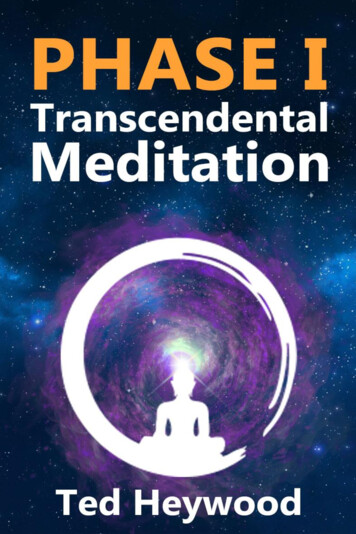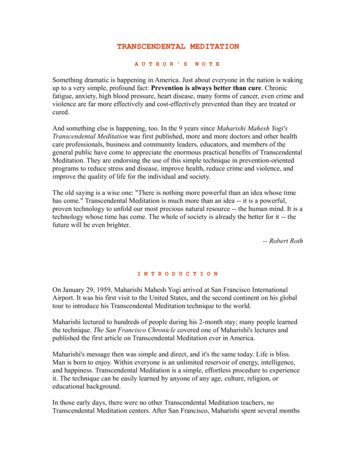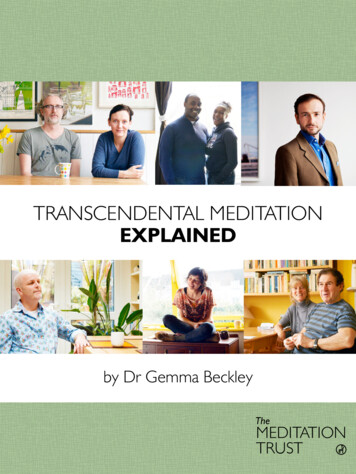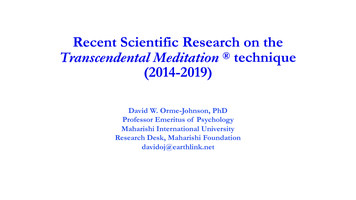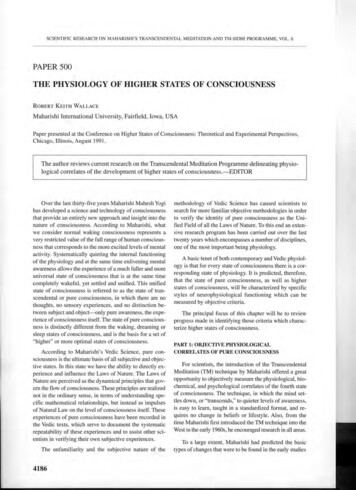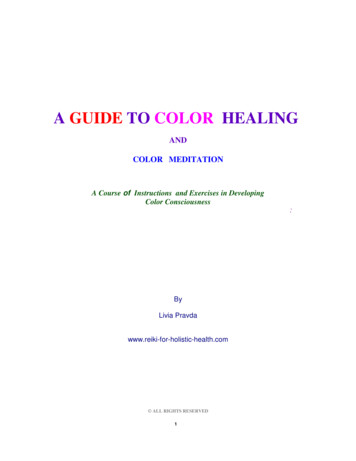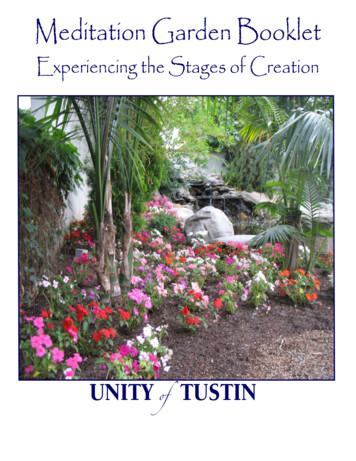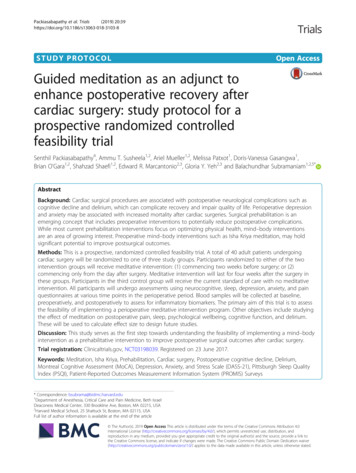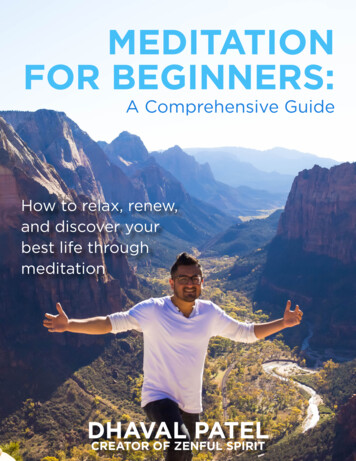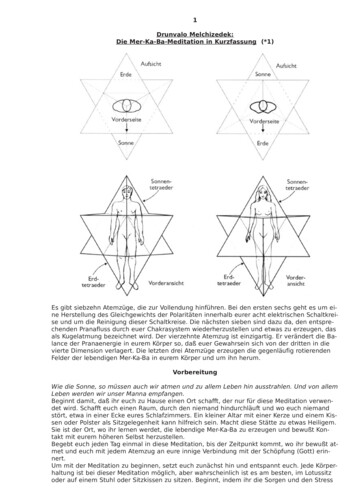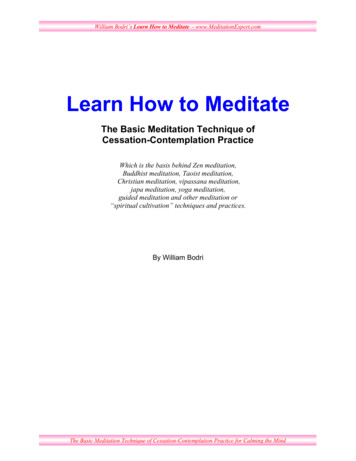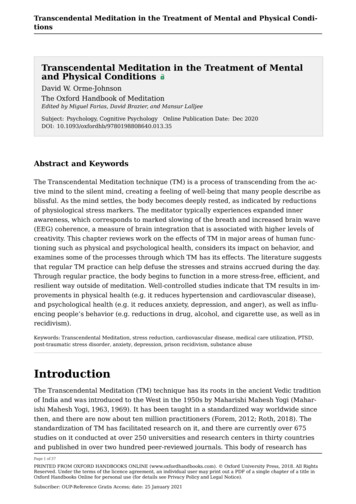
Transcription
Transcendental Meditation in the Treatment of Mental and Physical Condi tionsTranscendental Meditation in the Treatment of Mentaland Physical ConditionsDavid W. Orme-JohnsonThe Oxford Handbook of MeditationEdited by Miguel Farias, David Brazier, and Mansur LalljeeSubject: Psychology, Cognitive Psychology Online Publication Date: Dec 2020DOI: 10.1093/oxfordhb/9780198808640.013.35Abstract and KeywordsThe Transcendental Meditation technique (TM) is a process of transcending from the ac tive mind to the silent mind, creating a feeling of well-being that many people describe asblissful. As the mind settles, the body becomes deeply rested, as indicated by reductionsof physiological stress markers. The meditator typically experiences expanded innerawareness, which corresponds to marked slowing of the breath and increased brain wave(EEG) coherence, a measure of brain integration that is associated with higher levels ofcreativity. This chapter reviews work on the effects of TM in major areas of human func tioning such as physical and psychological health, considers its impact on behavior, andexamines some of the processes through which TM has its effects. The literature suggeststhat regular TM practice can help defuse the stresses and strains accrued during the day.Through regular practice, the body begins to function in a more stress-free, efficient, andresilient way outside of meditation. Well-controlled studies indicate that TM results in im provements in physical health (e.g. it reduces hypertension and cardiovascular disease),and psychological health (e.g. it reduces anxiety, depression, and anger), as well as influ encing people’s behavior (e.g. reductions in drug, alcohol, and cigarette use, as well as inrecidivism).Keywords: Transcendental Meditation, stress reduction, cardiovascular disease, medical care utilization, PTSD,post-traumatic stress disorder, anxiety, depression, prison recidivism, substance abuseIntroductionThe Transcendental Meditation (TM) technique has its roots in the ancient Vedic traditionof India and was introduced to the West in the 1950s by Maharishi Mahesh Yogi (Mahar ishi Mahesh Yogi, 1963, 1969). It has been taught in a standardized way worldwide sincethen, and there are now about ten million practitioners (Forem, 2012; Roth, 2018). Thestandardization of TM has facilitated research on it, and there are currently over 675studies on it conducted at over 250 universities and research centers in thirty countriesand published in over two hundred peer-reviewed journals. This body of research hasPage 1 of 37PRINTED FROM OXFORD HANDBOOKS ONLINE (www.oxfordhandbooks.com). Oxford University Press, 2018. All RightsReserved. Under the terms of the licence agreement, an individual user may print out a PDF of a single chapter of a title inOxford Handbooks Online for personal use (for details see Privacy Policy and Legal Notice).Subscriber: OUP-Reference Gratis Access; date: 25 January 2021
Transcendental Meditation in the Treatment of Mental and Physical Condi tionsbeen anthologized in seven volumes of collected papers on TM (Orme-Johnson & Farrow,1977; Chalmers, Clements, Schenkluhn, & Weinless, 1989; Wallace, Orme-Johnson, & Dill beck, 1990; Dillbeck, 2011; Dillbeck, Barnes, Schneider, Travis, & Walton, 2013).This chapter reviews work on the effects of TM in major areas of human functioning suchas physical and psychological health, considers its impact on behavior, and examinessome of the processes through which TM has its effects. However, it also has some omis sions. Discussion of work on the “Maharishi effect,” where it has been shown that groupsof people meditating together can have marked influences on various societal indices in cluding infant mortality and violent crime (Cavanaugh & Dillbeck, 2017a, 2017b; Dillbeck& Cavanaugh, 2016, 2017; Hagelin et al., 1999), is beyond the scope of the chapter. So al so is work by Alexander and colleagues integrating Maharishi’s descriptions of the stagesof enlightenment from the ancient Vedic tradition of India with concepts of higher levelsof mental health and cognitive development as conceptualized in contemporary psycholo gy (Alexander, Druker, & Langer, 1990; Alexander, Davies, et al., 1990; Alexander, Heaton,& Chandler, 1994; Orme-Johnson, Zimmerman, & Hawkins, 1997; Orme-Johnson, 2000;Dillbeck, 1983, 1990).What Is the Transcendental Meditation Tech nique?There are many definitions of the word “meditation.” For TM practitioners, meditationmeans transcending or going beyond the thinking level of the mind, hence the name“Transcendental” Meditation. During TM, one sits comfortably for about twenty minutesand silently repeats a mantra or sound as taught by the teacher, which allows the mind tosettle down to quieter levels. The TM mantras are ancient traditional sounds from theVedic tradition of India, which are said to have beneficial effects on all levels of the mind.They were handed down by Maharishi on behalf of the tradition to the TM teachers who,also on behalf of the tradition, pass them on to the TM students.Whereas other types of mantra meditations focus on the meaning of the mantras, an im portant feature of TM is that the mantras do not have a meaning. They are not Sanskritwords; they are just sounds. Their purpose is to keep the mind lively but undirected, be cause in that condition attention is effortlessly drawn to inner silent levels of the mind.Maharishi explains: “The manner in which Transcendental Meditation takes the mindfrom the gross to the subtle is very simple and based upon the innate tendency of all hu man minds to seek happiness. The very nature of the mind is to go to a field of greaterhappiness. The happiness referred to is not pleasure, nor sensual gratification, nor excite ment, but a tranquil and confident state of knowing—of knowing that ‘I am,’ of knowingthat ‘I’ exist and that it is permanent and unchanging” (Maharishi Mahesh Yogi, 2013).The Transcendental Meditation technique can only be learned from a certified teacherand not from a book or on the internet because learning it requires an interaction be tween the teacher and the student and instruction proceeds according to what the stu Page 2 of 37PRINTED FROM OXFORD HANDBOOKS ONLINE (www.oxfordhandbooks.com). Oxford University Press, 2018. All RightsReserved. Under the terms of the licence agreement, an individual user may print out a PDF of a single chapter of a title inOxford Handbooks Online for personal use (for details see Privacy Policy and Legal Notice).Subscriber: OUP-Reference Gratis Access; date: 25 January 2021
Transcendental Meditation in the Treatment of Mental and Physical Condi tionsdent experiences. Teachers of Transcendental Meditation are highly trained and certified,guaranteeing that instruction is standardized worldwide, which has protected its effec tiveness and facilitated research on it. It is taught in a standard seven-step course, typi cally over four consecutive days (Forem, 2012).This technique can be practiced anywhere, even on a bus or in a noisy airport, but a quietplace is preferable. One only needs a comfortable chair. It does not require any faith orbelief in it for it to work. It works even for skeptics. In fact, it is better to approach it in nocently, with no preconceptions about what is supposed to happen. As the mind settlesdown, the body settles down, and the person typically reports experiencing deep relax ation. Exactly what happens during meditation depends on the condition of the body. Ifone is fatigued, one might fall asleep. Thoughts inevitably arise, and the meditator istaught how to deal with them, and not to struggle against them or against noise. There isno concentration or control of the mind involved in TM, which distinguishes it from mostother meditation techniques.Figure 1. Photo taken in Fiuggi Fonte, Italy, June1972. From left to right are Peggy and Dr. VincentSnell, national directors of the TM organization inthe United Kingdom, Dr. David Orme-Johnson, andDr. Keith Wallace, who had recently published his re search on the physiological effects of TM in Science(Wallace, 1970a). I was explaining to Maharishiabout my research showing TM increases stability ofthe autonomic nervous system, which regulates emo tional and motivational responses.Cultural BackgroundIn the Vedic literature from which TM is derived, the state of deep inner peace has beenvariously called pure consciousness, transcendental consciousness, the Self, samādhi, at man. In the Vedic literature, Patañjali’s Yoga Sūtras described pure consciousness as yo ga, the union of the individual mind with the cosmic mind. It describes how this union isachieved as:Yogaś citta-vṛtti-nirodhaḥPage 3 of 37PRINTED FROM OXFORD HANDBOOKS ONLINE (www.oxfordhandbooks.com). Oxford University Press, 2018. All RightsReserved. Under the terms of the licence agreement, an individual user may print out a PDF of a single chapter of a title inOxford Handbooks Online for personal use (for details see Privacy Policy and Legal Notice).Subscriber: OUP-Reference Gratis Access; date: 25 January 2021
Transcendental Meditation in the Treatment of Mental and Physical Condi tionsyogaḥ union, transcendental consciousness, citta mind. vrtti activity, nirodhaḥcomplete settling, cessationYoga is the complete settling of the activity of the mind. (2)TM is seen as a means to achieve this end (Egenes, 2010).According to the Vedic tradition, pure consciousness is the fourth major state of con sciousness, different from waking, dreaming, and sleeping. For example, the MāṇḍūkyaUpaniṣad 7 states: “The fourth condition is Atman in his own pure state. It is neither out er nor inner consciousness, neither semi consciousness, nor sleeping consciousness. Itcannot be seen or touched. It is above all distinctions, beyond thought, ineffable. In theunion with him is the supreme proof of his identity. It is peace and love” (Mascaro, 1965;see also Katz & Egenes, 2015).Differences between Meditation TechniquesScientifically, TM is called automatic self-transcending because it is an effortless, auto matic process by which the mind transcends or goes beyond the technique itself. That is,it goes from effortless thinking of the mantra to silence. This process is associated with abrain wave (EEG) frequency of 8–10 cycles per second (Hz), called Alpha1, which is seenduring restful alertness, the state when the mind is resting but wide awake inside (Travis& Shear, 2010). Studies have shown that during specific periods of pure consciousnessthe breath markedly slows and the brain becomes globally coherent, as indicated by in creased EEG coherence among all cortical areas in all frequency bands (Badawi, Wallace,Orme-Johnson, & Rouzeré, 1984; Farrow & Hebert, 1982; Travis, 2001, 2004), which sug gests a high level of global integration in the brain.Meditation techniques that require focused mental activity have different physiologicaleffects. Non-reactive monitoring of one’s thoughts, as in some mindfulness (Open Moni toring) techniques, are associated with theta EEG (2–7 Hz), characteristic of that kind ofmental activity. Focused Attention meditation, voluntarily focusing attention on a chosenobject, is associated with gamma EEG (20–50 Hz), a frequency band generally known tocorrelate with focusing attention (Travis & Shear, 2010).Areas of TM Research Not Reviewed in ThisChapterThe reader may be interested to know that Alexander and colleagues have integratedMaharishi’s descriptions of the stages of enlightenment from the ancient Vedic traditionof India with concepts of higher levels of mental health and cognitive development as con ceptualized in contemporary psychology (Alexander, Druker, & Langer, 1990; Alexander,Davies, et al., 1990; Alexander, Heaton, & Chandler, 1994; Orme-Johnson et al., 1997;Orme-Johnson, 2000; Dillbeck, 1983, 1990). Maharishi described the growth of enlighten ment in terms of seven states of consciousness, of which waking, dreaming, and sleepingPage 4 of 37PRINTED FROM OXFORD HANDBOOKS ONLINE (www.oxfordhandbooks.com). Oxford University Press, 2018. All RightsReserved. Under the terms of the licence agreement, an individual user may print out a PDF of a single chapter of a title inOxford Handbooks Online for personal use (for details see Privacy Policy and Legal Notice).Subscriber: OUP-Reference Gratis Access; date: 25 January 2021
Transcendental Meditation in the Treatment of Mental and Physical Condi tionsare the first three, the four others being a sequence of higher states of consciousness(Maharishi Mahesh Yogi, 1963, 1969). This is the general theoretical framework fromwhich specific research hypotheses for TM research were derived.Another body of research studies beyond the scope of the present chapter is on collectiveconsciousness. According to the Vedic tradition, everyone and everything is interconnect ed by a common universal field of consciousness. Consequently, when we directly experi ence pure consciousness, a positive influence on others is radiated throughout the field.There have been over fifty studies showing that when the TM technique and its advancedprogram, the TM-Sidhis, including Yogic Flying, are practiced in a group of at least the 1percent of a population, they produce beneficial changes in the larger society. For exam ple, four recent studies in the United States have shown that when such a group wasformed in Iowa, there were simultaneous reductions in national rates of violent crime,motor vehicle fatalities, other accidental deaths, infant mortality, and drug-relateddeaths, which could not be explained by other events at the time (Cavanaugh & Dillbeck,2017a, 2017b; Dillbeck &Cavanaugh, 2016, 2017; Hagelin et al., 1999). Other studieshave reported reductions of armed conflict and terrorism, as well as improved coopera tion among nations acting as a whole when the requisite size groups are created (OrmeJohnson, Alexander, Davies, Chandler, & Larimore, 1988; Orme-J
Transcendental Meditation in the Treatment of Mental and Physical Conditions David W. Orme-Johnson The Oxford Handbook of Meditation Edited by Miguel Farias, David Brazier, and Mansur Lalljee Abstract and Keywords The Transcendental Meditation technique (TM) is a process of transcending from the ac
